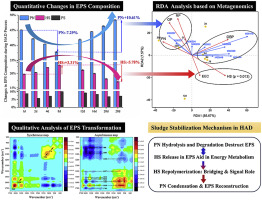Water Research ( IF 11.4 ) Pub Date : 2020-03-05 , DOI: 10.1016/j.watres.2020.115686 Yanfei Tang , Xiaohu Dai , Bin Dong , Yiqun Guo , Lingling Dai

|
High-solid anaerobic digestion (HAD) can directly treat dewatered sewage sludge (total solid content ≥15%) with superior volume efficiency. Sludge stabilization during HAD is expected to achieve by throughout organic degradation and conversion towards methane-rich biogas release and humic formation. Sewage sludge is the combination of microbial zoogleas and theirs adsorption of organic and inorganic matter, in which the extracellular polymeric substances (EPS) account 60–80% of total sludge organic matter, inevitably participating most extracellular metabolic pathways. The interactions between EPS transformation and genetically annotated metabolic pathways were found in this research. In brief, noticing the highly cross-linked structures in EPS with major active components of humic substances (HS) and protein (PN), as PN hydrolysis and decomposition in EPS were enhanced in the high-solid anaerobic condition, the exposure of aromatic groups and sites in HS were considerable. HS release was the main factor shifting the electron exchange capacity and activity, which aided in energy metabolism of sludge microorganisms involved in redox reactions, especially the methanogenesis, thus in turn facilitating the PN degradation; Then, the screened humic groups and active protein derives might act as the beneficial precursors to regenerate neo-humic structures, whose significant bridging effect and signal role on stimulating amino acid biosynthesis, member transport and metallic complexation could further contribute to proteolytic condensation and EPS reconstruction. Hence, the in-depth sludge stabilization mechanism during HAD process was established for developing enlightening strategies.
中文翻译:

高固体厌氧消化污泥稳定过程中,细胞外聚合物(EPS)的增湿控制甲烷释放和EPS重建
高固体厌氧消化(HAD)可以直接处理脱水的污泥(总固体含量≥15%),具有极高的容积效率。预计在HAD期间污泥的稳定将通过整个有机降解以及转化为富含甲烷的沼气释放和腐殖质形成而实现。污水污泥是微生物类动物油脂及其对有机物和无机物的吸附的组合,其中细胞外聚合物(EPS)占污泥总有机物的60-80%,不可避免地参与了大多数细胞外代谢途径。在这项研究中发现EPS转化与遗传注释的代谢途径之间的相互作用。简而言之,注意到EPS中的腐殖质(HS)和蛋白质(PN)的主要活性成分具有高度交联的结构,在高固体厌氧条件下,随着EPS中PN水解和分解作用的增强,芳烃基团和HS中位点的暴露量很大。HS的释放是改变电子交换能力和活性的主要因素,这有助于参与氧化还原反应的污泥微生物的能量代谢,特别是甲烷生成,从而促进了PN的降解。然后,筛选的腐殖质基团和活性蛋白衍生物可能是再生新腐殖质结构的有益前体,其新的桥接作用和信号在刺激氨基酸生物合成,成员转运和金属络合中的作用可能进一步有助于蛋白水解缩合和EPS重建。因此,











































 京公网安备 11010802027423号
京公网安备 11010802027423号